Come talk to me, Prof. Ravagnoli, about Research Opportunities over the Summer.
Logan Fellowship or Faculty-Student research are some of the ongoing possibilities.
Student hours: after noon on Tuesday and Thursday!

Come talk to me, Prof. Ravagnoli, about Research Opportunities over the Summer.
Logan Fellowship or Faculty-Student research are some of the ongoing possibilities.
Student hours: after noon on Tuesday and Thursday!
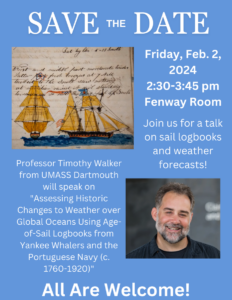
Join the students of HIST3412 Immigrant Kitchens in a fundraising dinner in the Auditorium on OCTOBER 13th
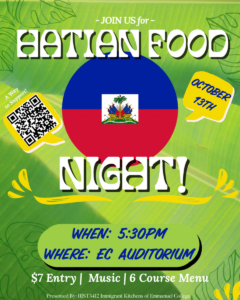

LISTEN TO DIGITAL HISTORY STUDENTS PODCASTING ON THE HISTORY OF EXPEDITIONS TO EVEREST!

Enjoy podcast hosts Julia Beal, Abigail Darling, and Laney Giusti!
Check out this fantastic piece on History Department’s great friend, lecturer, and storyteller extraordinaire CYNTHIA YEE
VISIT HER WEBSITE TO DISCOVER MORE STORIES
They successfully presented their research at the New England Regional Conference of the World History Association.
If you see them in the corridors, ask them about their research!
Annie Costello presented a paper titled: “Who is building the ship? The Thematic Plan to introduce Soviet women to the workforce through art”
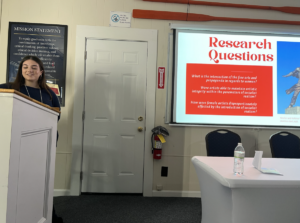
Kenneth Laurent presented a paper titled: “Trujillo El Marino: The US Marines role in the rise of Rafael Trujillo”
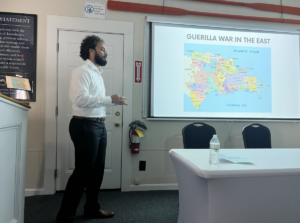
Caroline Tempesta presented a paper titled: “The St. Louis: Immigration Policy as Life or Death”
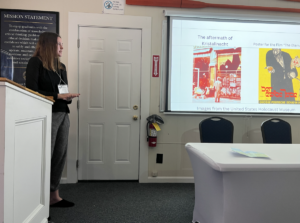
REMEMBERING WOMEN HISTORY
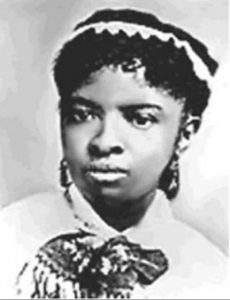
Dr. Rebecca Crumpler was the first female African-American doctor of medicine in the United States. Born in 1831, Rebecca was raised by her aunt in Pennsylvania, who acted as the community doctor, and moved to Charlestown, Massachusetts in 1852. Rebecca worked as a nurse from 1855 to 1864, and was admitted to the New England Female Medical College in 1860. Her husband, the former enslaved Wyatt Lee, passed away from TB in 1863. In 1864, she became a doctor and practiced primarily for Boston’s poor African-American women and children.
Rebecca married her second husband, Arthur Crumpler, a former fugitive enslaved man in 1864 or 1865. At the end of the Civil War, they moved to Virginia and Rebecca worked for the Freedmen’s Bureau to care for the enslaved who had been freed. Racism was rampant, and they moved back to Boston; Joy Street in Beacon Hill, when it was primarily an African-American neighborhood. Rebecca taught, gave birth to Lizzie in 1870, attended the elite West-Newton English and Classical School, and also wrote A Book of Medical Discourses in 1888. The Crumplers moved to Hyde Park in the 1880s.
Rebecca Crumpler died on March 9, 1895, and unfortunately there are no surviving pictures, paintings or drawings of her. She and Arthur are buried in Fairview Cemetery. Their former home on Joy Street is part of Boston’s Black Heritage Trail, and the Women’s History Trail. One of the first medical societies for African-American women, is named in Rebecca’s honor. Dr. Rebecca Cole, another female African-American first in her own right, is often confused with Dr. Rebecca Crumpler. Dr. Crumpler received her degree 3 years earlier than Dr. Cole.
Friends of the Hyde Park Library have started the Crumpler Fund to raise money to provide Rebecca and Arthur with proper gravestones in Fairview Cemetery. Donation info is here.
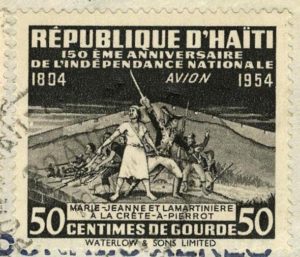
Marie-Jeanne Lamartiniére, often known only as Marie-Jeanne, was one of a few women who served in the Haitian army during the Haitian Revolution. Unfortunately, not much is known about her early life. Dressed in a man’s uniform, she fought alongside her husband, Louis Daure Lamartiniére at the Battle of Crête-à-Pierrot in 1802. She fought courageously which helped to boost morale, and she also nursed her wounded comrades. Her husband was killed during an ambush later in 1802.
Marie-Jeanne Lamartiniére’s life after independence from France is mostly unknown, though there are a few stories. Two other known female revolution fighters to check out are Abdaraya Toya aka Victoria Montou, and Sanité Bélair.
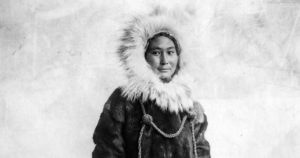
Ada Blackjack, an Inupiaq woman, lived as a castaway on the uninhabited Wrangel Island, north of Siberia for a few years due to a disastrous expedition. Born in Alaska in 1898, she was raised by missionaries who taught her English and domestic skills. Later in life, struggling as a single mother to a sick child, she placed him in an orphanage until she could provide for him. In 1921, she saw the opportunity, and joined the Wrangel Island Expedition, funded by Vilhjalmur Stefansson. His reasonings for the expedition are a little sketchy; maybe a little self-promotion, and/ or trying to make up for Karluk disaster, but either way, mistakes and bad choices were made.
Ada was misled to think that the expedition would be made up of more Alaskan Natives. The rest of the team of men included one American and three Canadians who were inexperienced with Arctic exploration. Ada was hired as the cook and seamstress. The team was to be relieved by a new one in 1922, but the ship never showed up.
In January of 1923, conditions turned disastrous; rations ran out, and three team members left to find help and food. Ada was left with Victoria the cat, and Lorne Knight who had scurvy,. She nursed him even though he was verbally and mentally abusive towards her. Lorne died in June, and the other three men never returned.Ada knew no survival skills. On her own, she learned how to shoot and trap foxes. She hauled driftwood and chopped it for fire. Ada built two lightweight boats out of driftwood, canvas, and animal skin so she could hunt more successfully.
Ada Blackjack and Victoria were rescued in August of 1923, by Harold Noice. They had been on the island for almost 2 years. Ada didn’t profit from any of fanfare over the expedition, was able to get her son back, gave birth to another son, didn’t give interviews until she was much older, and struggled with poverty for the rest of her life. Ada died in Anchorage in 1983, at 85.
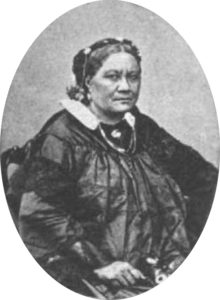
Pōmare IV, born ʻAimata Pōmare IV Vahine-o-Punuateraʻitua in 1813, was the Queen of Tahiti from 1827 to 1877. She was the fourth monarch of the Kingdom of Tahiti. In 1843, France declared Tahiti a French protectorate and installed a governor. Pomare tried to stop further French intervention by writing to the King, Louis Philippe I, and asked Queen Victoria for help. In protest, Pōmare exiled herself to Raiatea. The French-Tahitian War took place from 1843-1847, and involved all of the Society Islands. The French won, but because of pressure from England, they were unable to take over Tahiti, so the island and Moorea were ruled under the French protectorate. A clause in the war settlement stated that Queen Pōmare’s allies, Bora Bora, Raiatea and Huahine remain independent.
Queen Pōmare IV ruled under French administration from 1847-1877. She placed some of her 10 children in positions of power in Tahiti and the Leeward Islands, including her daughter Teri’i-maeva-rua I, who became Queen of Bora Bora. She died in 1877 and was succeeded by her son.
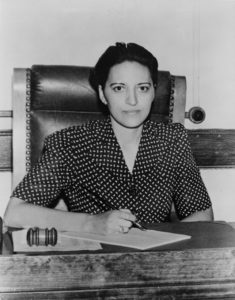
Jane Bolin was a woman of firsts. She is mainly known as the first African American female judge in the US. Born in 1908, her lawyer father Gaius was also a man of firsts, including the first black graduate of Williams College. Due to racism, Jane and the only other black student in her freshman class moved off of Wellesley College’s campus, but she graduated in 1928 as a “Wellesley Scholar.” She was the first African American to earn a law degree at Yale, as well as the first African American woman to join the NYC bar association, and the first African American female lawyer hired by the NYC Law Department. She was sworn in as a family court judge in 1939 by Mayor La Guardia. Jane promoted the requirement of child care agencies that receive public funding, to accept children regardless of their race or ethnicity, and ended the practice of assigning probation officers based on race or religion.
Jane Bolin was reappointed to her seat by three more mayors, for three more 10 year terms. She retired when she hit the mandatory retirement age of 70, and she continued to advocate for children’s rights and education. Jane died in 2007 at the age of 98.
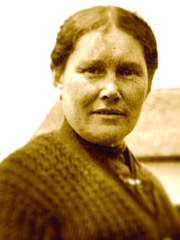
Ga’axstal’as, also known as Jane Constance Cook, was a First Nations leader and activist of the Kwakwaka’wakw people. Born in 1870 on Canada’s Vancouver Island to a noblewoman and a white fur trader, Jane was raised by missionaries, and trained as a midwife and healer. She was bilingual, and had a good understanding of colonial legal and government systems. Jane fought for land and resource rights for her people, and advocated for women and children. In 1914, she testified at the McKenna-McBride Royal Commission, and was the only woman to serve on the executive of the Allied Indian Tribes of British Columbia.
Jane Constance Cook raised 16 children, and died in 1953.
Written by Jaclyn Foster
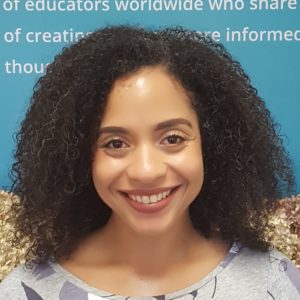
Jackie graduated from Emmanuel in 2006 with a BA in history and secondary education. She has a masters degree from Boston College. She is currently the Manager, Program Operations at Facing History and Ourselves.
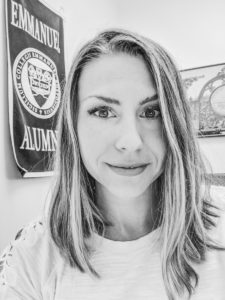
No kid wants to be a Registrar when they grow up. I didn’t. I suppose that is because I didn’t even know what a Registrar was until I was in college. I suspect the case to be the same for many others. And even then, the Registrar was just the office who coordinated schedules and processed transcripts, right? Well yes, and much more. I’ll get to that later.
In the 10th grade, I had the most wonderful AP European history teacher. I fell in love with history. I just knew I wanted to be like that teacher I had in high school. I had every intention of molding the minds of high-schoolers with analysis of primary source documents and lively discussion over my favorite historical periods. Even today, I’m drawn to articles on European history or historical fiction novels, and don’t even get me started on following the British Royal family on Instagram.
My career at Emmanuel started as an undergrad as a history and secondary education major. The college history classroom was one of my favorite places and I wanted to recreate that experience for grades 9-12 and hoped to one day be a professor myself. My love of history only deepened at Emmanuel.
I fell into the world of higher ed when I realized my chosen career of history teacher, after 4 years of study at Emmanuel and one year of teaching post-graduation, was not for me. An email from a former professor asking if I needed textbooks, prompted a confession that I wouldn’t be teaching the next year and I sought advice as to what to do with my history degree. And so, I ended up back at Emmanuel in the Office of the Registrar as a Registrar Services Representative. Today, eleven years later, I am the Registrar at Emmanuel College. I’ve found my career. While probably not initially apparent, a degree in history gave me the skills I needed to advance and succeed within the Registrar’s Office.
The Registrar, as explained by Kimra Schipporeit, is a historical position in and of itself, dating back to at least 1446 in Oxford, England. (12) Of course we facilitate registration and process transcripts and provide enrollment verifications to defer your student loans and get discounts on car insurance, but we also provide historical data and enrollment information to departments to inform course offerings, demand for new programming or other decision making on campus, maintain and update the student academic record including grades, major declarations, academic exceptions, build the academic curricula into the student information system, review degree requirements and clear students for graduation, evaluate transfer credit, enforce academic policy and we actually have a big role in the commencement ceremony!
Registrars must be detailed oriented. We are the “custodian of the student academic record” and maintain historical records of transcripts (even going back to our first class starting in 1919!), college policy, curriculum adjustments, academic exceptions, graduation records, and ensure students are on track for graduation. We prepare meticulous lists for various departments on campus for honor societies, course offerings and provide information for federally mandated reporting. Details and accuracy matter. If historians can be stereotyped for obsessing over details, I think we can lump registrars into that category too. Maybe with the exception of the library, we are the academic historians of the college.
Registrars know the details…but also understand the big picture. The Registrar’s Office is, I would argue, an unsung hero in higher ed. We are the hub of the College, the “heart” if you will, according to, University Registrar Emeritus Dennis L. Geyer. (27) We are one of the few departments whose day to day responsibilities involve working intimately with Academic Affairs and Faculty, Academic Advising, Admissions, Residence Life, Student Financial Services, Study Abroad and International Programs and Student Affairs. Because of these relationships, registrars need to be able to view both the macro and the micro..and how they intersect and impact one another. Being so connected, we are able to anticipate how actions, policies, or procedures impact other stakeholders and factor this into our own practice or decision making, when others who do not have connections may not be able to make these same assessments. A degree in history helps you understand interconnectivity and knowing what and how the details executed impact the big picture.
Registrars are research minded. In our efforts to improve our own efficiencies and experiences for students or assist the College in decision-making, the Registrar’s Office is often tasked with researching policies and practices at other institutions. The work we do helps to inform policies and procedures that impact curricula or the student experience. The skills one develops in writing history papers and researching secondary sources, primary source documents, and peer reviewed journals, are useful in many professions, including mine.
Registrars need to be excellent communicators. We communicate with many departments on campus, including faculty, as well as with students and often their families. My preparation as a history major taught me to write comprehensively, anticipate future questions, and use data and evidence to support my position. In writing this way, a registrar can provide the College with information they need for decision making, or for a student to clearly understand college policy and requirements needed to graduate on time, or the rationale for developing a new policy or process on campus. Often I need to write diplomatically, explaining policy or process, and in a such a way as to temper any feelings of dissatisfaction a student may have had when they first approach us. Words (and the way they are communicated and supported) matter.
In 2014, I earned my Master of Science in Management from Emmanuel College (see how great this place is, I can’t leave!). While I would have loved to have received a graduate degree in history, I took advantage of the options available to me at Emmanuel, and in an area that I was also starting to gain a passion- management and process improvement. Surprisingly, I found that the skills that I had acquired earning my undergraduate history degree, prepared me for graduate school and I think set me apart from some of my peers with other backgrounds. My research skills, ability to properly cite sources, and to understand the cause and effect, were easily transferable in defending positions I had taken for projects on process improvement, leading teams, organizational development and strategic planning and management. The skills then that I acquired in graduate school directly impacted my professional advancement within the College.
I think it’s easy for someone who doesn’t love history to ask what you are going to do with a history degree…especially if you are unsure if you want to be a historian, or a teacher, or go to law school. But studying history gives you so much. I may not be discussing the Renaissance with 14 year olds or grading 5 paragraph essays, but I put my history skills I learned here at Emmanuel to use every day, while I wait for the next “Maggie Hope” historical WWII spy fiction novel to drop in February 2020, and still get to do some of the things I loved about teaching without actually teaching-but that might be a different post for the Education Department…
Works Cited:
Geyer, Dennis. “Managing the Registrar’s Office.” Registrar’s Basic Guide, by American Association of Collegiate Registrars and Admissions Officers. 2018. pp. 27-32.
Schipporeit, Kimra. “The Role of the Registrar.” Registrar’s Basic Guide, by American Association of Collegiate Registrars and Admissions Officers. 2018. pp. 3-8.
After the new year I joined my fellow peers in travelling to Peru as part of the course on the Politics of Race and Ethnicity in Latin America. The class focused on a few South American countries, including Peru, and explored the effect that Spanish colonization and Catholicism has on today’s social structure and politics. Professor Vamvakas believed that travelling to Peru, and examining the fragile social structures first hand would be the most effective wayto fully grasp the scope of the situation. He was right. Traveling to Peru has reshaped my view of Latin America and the source of its social challenges. Like the United States, they are still battling their own racist tendencies.
Peru is a diverse, beautiful, and vibrant country with delicious food, gorgeous views, and a history that is unlike any other. Before the arrival of the Spanish, the illustrious Inca Empire dominated the Andes and Coast. The Incas were an advanced civilization with a complex cosmology and precise linguistic forms of expression and record keeping. They possessed the knowledge to build grand structures that survived Spanish colonization, mother nature, and modern tourists.
Machu Picchu is breathtaking. 8,000 feet above sea level, you can either hike to the site, which takes about 4 hours or you can take a 20-minute bus ride to the very base of the complex. The hike to the very top takes another 20 minutes. The mountain overlooks the Urubamba river that weaves through the mountains and connects with the Amazon through a tributary system. Driving up the mountain, ascending into the clouds, the river below resembles a snake. Fear starts to creep in. The fear of the bus tipping turns a 20-minute bus ride into a 20-hour flight! Thankfully, we survived.

Once you reach the top of the mountain, the first thing you see are llamas. They live atop the mountain and graze all day. Llamas originally were used for clothing, transportation, and sacrifice. Today their purpose is purely entertainment. It is easy to imagine, almost 500 years ago, this place milling around with people, exchanging household items and fruit. Despite being destroyed by mother nature, most of the walls are standing intact. These structures have survived inumerable rainstorms and floods, thanks to the Andeans’ advanced building methods. Machu Picchu is one of the last tangible artifacts from the Inca era.

Before we travelled to Cusco, and climbed Machu Picchu, we attended a lecture in Lima by Professor Juan Carlos Callirgos who commented on the confused Peruvian identity and how it negatively affects children and alters their self identity. Callirgos connected this confusion to the arrival of the Spanish and the imposition of values, religion and language onto the Andean people. The Spanish worked to rid Peru of any semblance of the Inca culture because it was seen (in the eyes of the Spanish) as ‘sinful.’ He argued the Spanish weaved classism and racism into Peruvian society by favoring lighter, less native Peruvians and encouraging the discrimination of darker, more indigenous Peruvians. Over time, Callirgos argued, these ideas were ingrained in Peruvian society; it prevented poor Peruvians from moving out of poverty and achieving the same success as their lighter, distant relatives.
One of the first tours we did in Cusco was of the Cusco Cathedral, which is one of the most beautiful cathedrals I’d ever seen. Inside were paintings by local townspeople of different biblical figures and events. One painting recreated of the Last Supper with cuy (Guinea Pig), Peru’s national dish, as the main course.There were beautifully crafted statues made from gold, silver and other precious metals to pay tribute to Jesus Christ and God. After our group toured the Cathedral, we exited on a different side of the building for a new perspective of the square. On the right side of the building is an Irish pub gifted the name “Paddy’s Irish Pub”. Inside was a typical Irish pub, a wooden bar with stools, booths for larger parties with Guinness on tap. The most unique and Peruvian aspect to the pub were the Juliette balconies and bistro chairs. I think it was the owners’ attempt to make this Irish pub seem more Peruvian and attract locals as well as tourists.
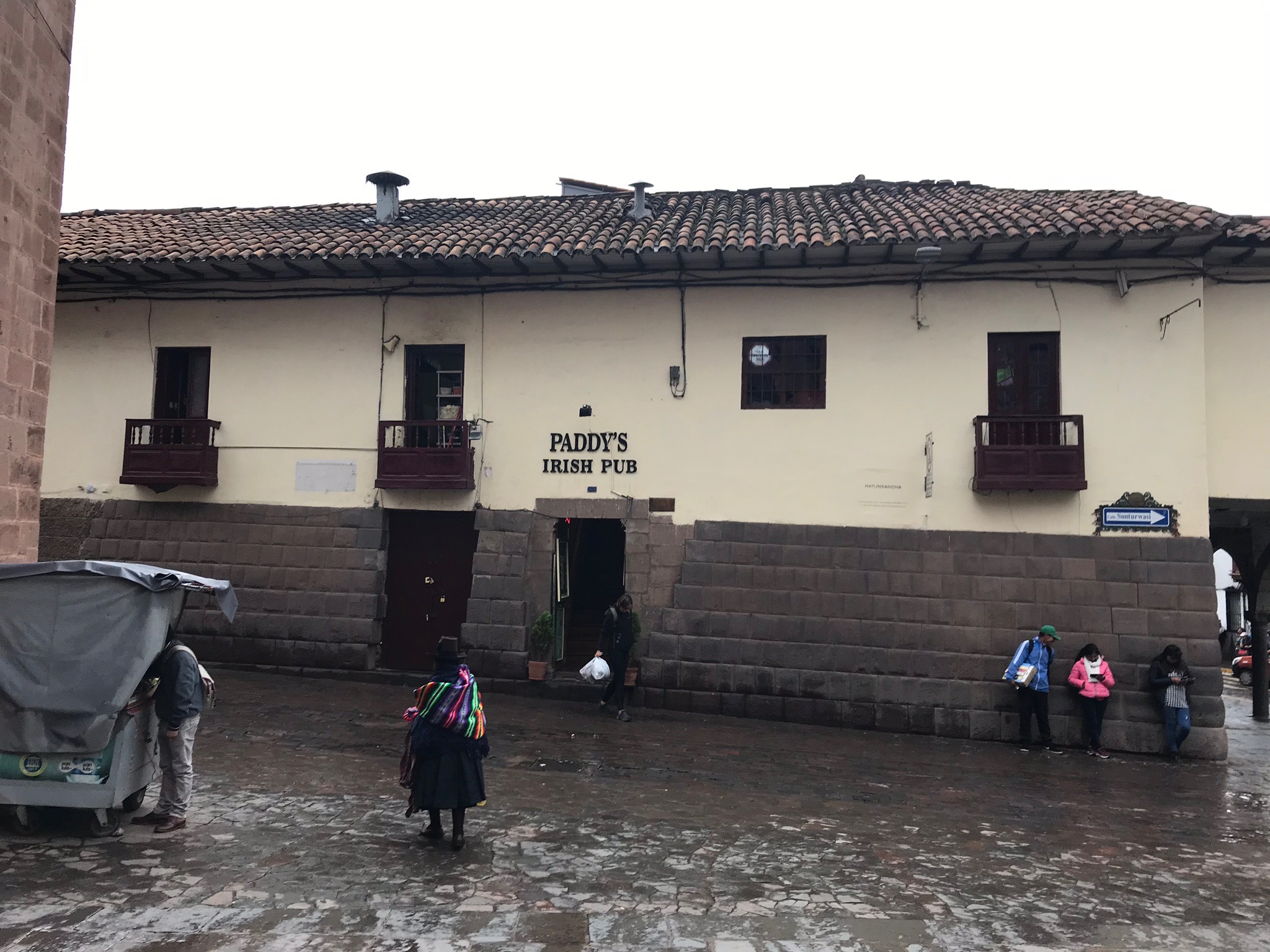
Paddy’s Irish Pub sheds light on how Europe reshaped Peru. The Andeans participated in drinking events during religious ceremonies but it was never used as a way to socialize the way the Irish (and many Europeans) see drinking. But these pubs introduced casual drinking into Peruvian society. The pub is no doubt enjoyed by both tourists and Peruvians but the mere fact that an Irish pub is near Cusco’s central plaza- the center of the Inca Empire- sheds light on a new and globalized layer to Peru’s identity. There are few relatively remaining artifacts from the Inca era, Machu Picchu being the most famous.
Ava Doogue
History Major, 2020